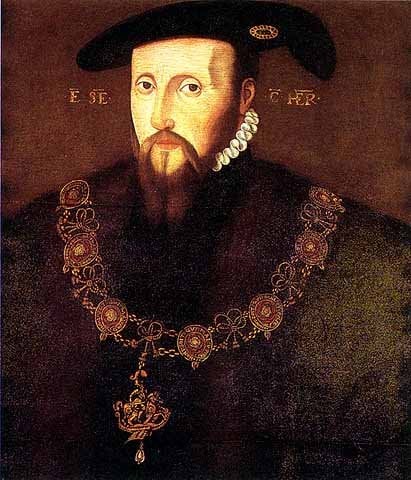Edward Seymour Executed for Treason on Orders from His Nephew
Edward Seymour, 1st Duke of Somerset

On January 22, 1552, Edward Seymour was executed. Edward Seymour was the older brother of Jane Seymour, Henry VIII’s third wife, and the uncle and Lord Protector of King Edward VI. He attempted to save his brother, Thomas Seymour, on at least two occasions who had gotten in trouble with the law but failed and found himself being the only Seymour left. However, Edward soon found himself on the wrong side of the council and was executed on January 22, 1552.
The Young Edward Seymour
Like his brother, Thomas, Edward Seymour was an ambitious man. It is likely that he pushed for his sister’s marriage to the King of England, who was married to Anne Boleyn at the time. He was born around 1500 and was appointed to Mary Tudor’s household in 1514.
He married Catherine Fillol in 1527 but this was annulled shortly after. The Dictionary of National Biography disputes the reason but it was allegedly over a relationship between Fillol and Edward’s father, Sir John Seymour. Edward later married Anne Stanhope on March 9, 1534.
Edward rose in power quickly after his sister's marriage to Henry VIII. In 1536 he became the Viscount Beauchamp and then a year and a half later was given the title Earl of Hertford. After Jane’s death in the October 1537, Edward Seymour became the Warden of the Scottish Marches and continued to grow in power. This supports the idea that Jane Seymour was Henry VIII’s one true love.
Read More About Edward Seymour
Edward Seymour is Named Lord Protector
In Henry VIII’s last will, 16 men were named as executors of Edward VI, who was just nine years old when his father died on January 28, 1547. Edward Seymour was one of those men. There is much controversy over the last will of Henry VIII, which is something that will be covered in more detail at a later date. The will made it possible for the lands and honours to be distributed between the court. Edward Seymour was named Lord Protector of the Realm and Governor of the King’s Person. This was not a title given in the will.
Henry VIII chose that the whole government would be there to reign during his son’s minor years. This would allow a majority decision and prevent one person taking power. However, 13 of the 16 members of the council – the three were absent – rules that there should be a Protector justified as “by virtue of authority”. It is unclear how Edward became the Lord Protector; he may have made a deal with some of the men, which is something that he did with William Paget and Sir Anthony Browne.
However, it seems that Edward would have been one of the best choices. He had proven his success in leading when taking the military to France and Scotland. However he gained the role, Edward gained letters from his nephew that granted him almost monarchical right for appointing members to the Privy Council in March 1547. He ruled by proclamation in most instances and only used the Privy Council for stamping his decisions.
Succeeding Thomas Seymour
His brother, Thomas Seymour, had missed out on the majority of the power and demanded that he have the governorship of the king’s person and more share of the power. Edward did not want this and gave his brother the title Lord Admiralship and placed him within the Privy Council. Thomas Seymour continued to scheme for more power and smuggled money to his nephew and bribed people. When Thomas was caught, Edward tried everything to save his brother by setting up a meeting with the Privy Council for Thomas to explain his actions; Thomas failed to attend.
Thomas was arrested in 1549 and found guilty of 33 charges of treason. Edward again tried to save his brother by delaying the signing of his death warrant. The council went over Edward’s head to the King of England, who signed the documents and Thomas Seymour was executed on March 20, 1549.
Edward Seymour’s War Against Scotland
Edward Seymour had already proven himself as a soldier and once he became Lord Protector he looked at a war against Scotland. In September 1547, he won at the Battle of Pinkie Cleugh and was able to get an army as far north as Dundee. However, his army suffered from a loss of direction and there was the problem of Scotland’s ally with France. The royal finances suffered from the war, especially with creating the permanent Scottish garrisons. Edward had no choice but to retreat and withdraw from the country in the August of 1549 after the French attacked Boulogne.
England was also struggling with social unrest and there were a number of grievances, especially religiously. The move from Catholicism to Protestantism was still fresh and a trouble. Edward was a reformer, along with his nephew, and they wanted the English people to follow the reformist ways but there were still many devout Catholics fighting against that.
The Downfall of Edward Seymour
Over time, Edward Seymour found that his position as Lord Protector was under threat. He took King Edward VI and went to Windsor Castle with him. During that time, the Privy Council published all the details of the way that Edward had mismanaged the government and it was soon clear that Henry VIII’s will never named him as Lord Protector.
A summary of the charges against Edward Seymour were made in Edward VI’s Chronicle and included the rash wars, his ambition and enriching himself. John Dudley, the father-in-law of Lady Jane Grey, became the leader of the Privy Council in February 1550 and Edward Seymour was initially placed in the Tower of London. However, Edward failed to keep himself out of trouble – much like his younger brother. He planned to overthrow Dudley but failed and was arrested for treason.
Edward Seymour was executed in 1552 and his body was placed with others who had been executed before him at St. Peter ad Vincula.









